The most commonly used line for trout fishing is monofilament or nylon with a breaking strain of 4 to 6lb.
Experienced fishermen might go as low as 2lb when targeting small trout in very clear water. Anglers targeting trophy trout or steelheads might go as high as 12lb.
The line you fish with might just be the most important part of your fishing setup. It is what connects your ‘lure’ with the reel.
It has to survive getting cast and reeled back in hundreds of times. It will rub against rocks, branches, and even the fish itself. Line choice is also very important when it comes to sensitivity.
While it might be tempting, fishing line is not a place to save a few dollars on an inferior product
Quick Recommendation
If you want to save time and skip the explanations. Then a good first line to use is 6lb Stern Original monofilament.
If you want a thinner line, then try the 4lb. This was my first line, and it is an excellent fishing line to learn to catch trout with.
Stern Original is a well proven, very forgiving monofilament with excellent knot strength and good abrasion resistance. While it does not offer the best sensitivity, it is good enough to detect the majorities of strikes and vibrations.
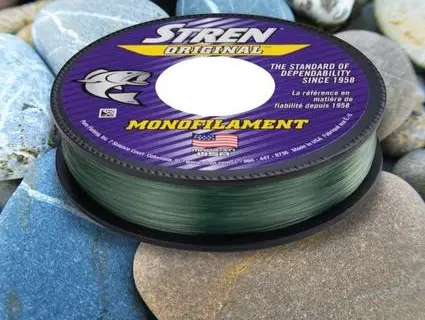
How to determine which breaking strain to use?
A rough guide is to use line no weaker than half the weight of the fish you are expecting to catch. So if the biggest fish you expect to catch is 6lb. Then you can usually get away with 4lb line.
Because water suspends the trout during the fight, the line does not have to ‘carry’ the entire weight of the fish. So it is possible to catch fish that weigh massively more than the breaking strain of the line you are using.
Buy your line based on diameter rather than breaking strain
When choosing which line to use, I suggest basing your decision on line diameter rather than breaking strain. It tends to be a more accurate indicator of line strength, than the breaking strain written on the package.
A 6lb line, should be no thicker than 0.009″ (0.23mm), while a 4lb line should be around 0.008″ (0.20mm). True 2lb lines are rare, but they typically have a diameter of around 0.005″ (0.12mm).
If you buy a 0.01″ line, such as Berkley Trilene XT, you can be assured it will break at quite a bit over the advertised 6lb. It will also be that much more visible to the trout, and the extra thickness will undoubtedly increase resistance reducing casting distance.
I have tested the breaking strain of quite a few lines over the years, and I can tell you. That the much thinner Sunline Super Natural breaks very close to the advertised breaking strain, while most other brands over test by quite some margin.
Specifications of various trout lines
| 6lb | 6lb | 4lb | 4lb | 2lb | 2lb | Country of Manufacture | |
| Inches | mm | Inches | mm | Inches | mm | ||
| Maxima Ultragreen | 0.009 | 0.22 | 0.007 | 0.178 | 0.05 | 0.12 | Germany |
| Sunline Super Natural | 0.008 | 0.205 | 0.006 | 0.165 | Japan | ||
| Sufix Elite | 0.01 | 0.254 | 0.008 | 0.203 | China | ||
| Sufix Siege | 0.01 | 0.254 | 0.008 | 0.2 | China | ||
| Stren Original | 0.009 | 0.23 | 0.008 | 0.2 | United States | ||
| Berkley Trilenle XL | 0.009 | 0.23 | 0.008 | 0.2 | 0.005 | 0.12 | United States |
| Berkley Trilene XT | 0.01 | 0.25 | 0.008 | 0.2 | United States | ||
| Platypus Classic | 0.09 | 0.23 | 0.007 | 0.18 | Australia | ||
| Kastking Premium | 0.09 | 0.23 | 0.008 | 0.2 | China | ||
| Stren Magnathin | 0.008 | 0.2 | 0.007 | 0.17 | United States | ||
| Trout Magnet SOS | 0.01 | 0.25 | 0.008 | 0.2 | 0.06 | 0.16 | China |
| Yo-Zuri Hybrid | 0.01 | 0.25 | 0.009 | 0.235 |
Claimed vs actual breaking strength of 6lb line
| Diameter (mm) | Actual Test (lb) | Actual kg | |
| Trilene XT | 0.25 | 9.1 | 4.1 |
| Yozuri Hybrid | 0.25 | 7.5 | 3.4 |
| Sufix Siege | 0.254 | 7.4 | 3.3 |
| Trout Magnet SOS | 0.25 | 7.3 | 3.3 |
| Sufix Elite | 0.254 | 7.1 | 3.2 |
| Trilene XL | 0.23 | 7.0 | 3.2 |
| Stren original | 0.23 | 7.0 | 3.2 |
| Stren Megathin | 0.2 | 6.6 | 3.0 |
| Sunline supernatural | 0.205 | 6.2 | 2.8 |
| Maxima Ultragreen | 0.22 | 6.1 | 2.7 |
| Maxima chameleon | 0.23 | 5.7 | 2.6 |
So, I will briefly discuss my line-breaking strain results. I tested dry 6lb line (Moisture weakens monofilament). I applied constant downward pressure until the line broke and used electronic scales to record the maximum weight. I was not testing knot strength.
The result for Trilene XT is strange. It is a significant outlier I almost wonder if I got a wrongly labeled spool containing 8lb line. I do plan on testing a new spool when I get the chance.
Maxima chameleon is also an outlier in the opposite direction, it broke significantly below what I expected given it’s diameter. This makes me wonder if I got a defective spool of line or old stock. I also plan on getting another spool and retesting.
Only two brands tested close to the rated breaking strain of 6lb, these were Sunline Supernatural and Maxima ultragreen. Both these lines are popular among enthusiasts and have a reputable for quality.
The other brands were overtesting by quite some margin. So, if you want to fish a line that is truly 6lb, probably best to get one with a diameter of around 0.20mm or 0.008 inches.
While Stren Oringal and Trilene XL had the same actual test result, I need to point out there was more variation in the results for the Trilene.
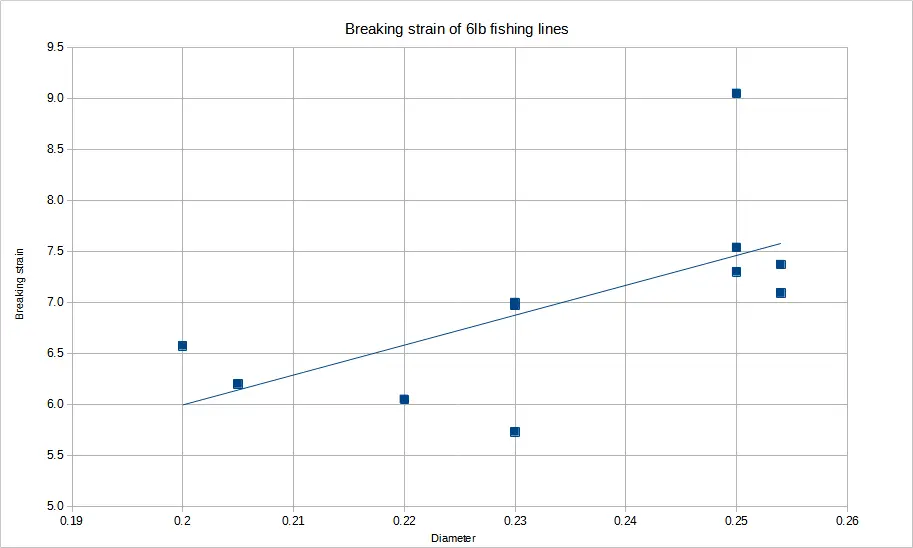
I also decided to throw the data into a graph, to show how there is a strong correlation between increasing diameter and breaking strain. So, while there is some slight variation, the trend line still shows that stronger lines are thicker lines.
What is the best monofilament line for trout fishing?
There are many good monofilaments on the market, they are probably only outnumbered by the bas ones. Below I will share my thoughts on what I consider to be the best monofilament lines for trout fishing.
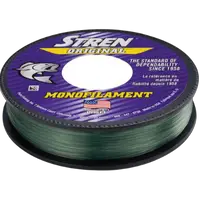
Stren Original – (Best value trout line)
Stren original is great value for money.
For example, a 330yd spool costs little more than $7. It has been around for decades and has barely changed in that time. Simply a great fishing line that is still made in the united states.
It casts well, has decent abrasion resistance, an average amount of stretch, and reliable knot strength. In my testing, the line showed little variation in breaking strength.
It was the first trout line I ever fished with and I still rate it among the best. Available in 4, 6lb, and higher breaking strains.
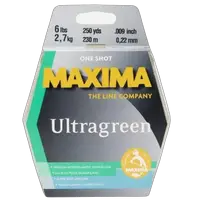
Maxima Ultragreen – (recommended)
This might just be one of the oldest monofilaments still on the market. I remember my dad using it when I was barely five.
This German-made monofilament has survived the decades because it is good. Just to prove the pedigree of Maxima Ultragreen, I know experience fly fishermen who use mainline spools of Ultragreen for tying their leaders.
It is slightly soft with very little memory and excellent knot strength. The diameter is thin, so the breaking strain reflects that. It is close to label specifications.
It is available in 2lb, 3lb, 4lb, 5lb, 6lb, and heavier.
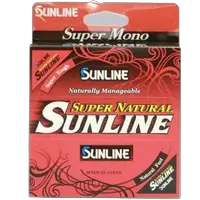
Sunline Super Natural – (Recommended)
This Japanese line is made to very high specifications and unlike some of the other lines on this list, it breaks very close to its marketed breaking strain.
Sunline Super Natural is a very consistent line but is more expensive than most.
The line is slightly soft, but somehow still manages to maintain better than average abrasion resistance. Care needs to be taken when tying knots.
Available in 4lb, 6lb, and higher.
Berkley Trilene XL
I have read that Trilene XL is the best-selling line in America. It is made by the same parent company as Stren.
I have filled countless spools with Trilene over the years and it never disappoints. Just a solid dependable line. It is extremely similar to Stren Original. It might even be the same.
Trilene Xl is available in 2lb, 4lb, 6lb, and higher breaking strains making it ideal for trout fishing.
Stren Megathin
Very thin, and very soft. There is barely any memory and it casts smoothly.
Knot strength is good for the diameter. It has very low abrasion resistance, so not a good line for fishing around structures or in harsh environments.
I like megathin, but it is not for everyone.
Sufix Elite
This line has similar characteristics as Trilene XL, it has low memory and is a nice forgiving line to fish.
Some anglers rate it as having better abrasion resistance than Trilene XL. This is to be expected due to the thicker diameter. In my testing, it had more variation in breaking strength.
I personally do not see any compelling reason to purchase it over Trilene XLL or Stren Orignal.
Available in 4lb, 6lb, and stronger breaking strains.
Sufix Siege
This is a competitively priced mono, that is stiffer and thicker than average.
In theory, this stiffness is meant to improve casting distance but on the water, any difference is hard to notice.
Good abrasion resistance and decent knot strength. I use it when surf fishing, but there are better lines for trout spinning.
Available in 4lb, 6lb, and stronger breaking strains.
Trout Magnet SOS
This monofilament is marketed directly at trout fishermen. It has a strong following, but I feel there are better lines out there.
Trout Magnet has decent knot strength and good abrasion resistance. Slightly thick diameter for its breaking strain but memory is not really a problem. I suspect it might be a relabel of another line on this list.
The 2lb trout magnet line is rather thick for its breaking strain and actually overtests by quite some margin. In my opinion, it is not a true 2lb line. Not bad, but not my favorite line
It comes in three breaking strains of 2, 4, and 6lb.
Trilene XT
Trilene XT is thicker than XL, which results in better abrasion resistance. I also suspect it has a harder coat, which further improves abrasion resistance.
Either way, XT is more durable but also stiffer with slightly worst knot strength and more memory.
I use XT when I am beach fishing for sharks due to their sandpaper skin. XL is better for trout fishing, unless in a very abrasive environment.
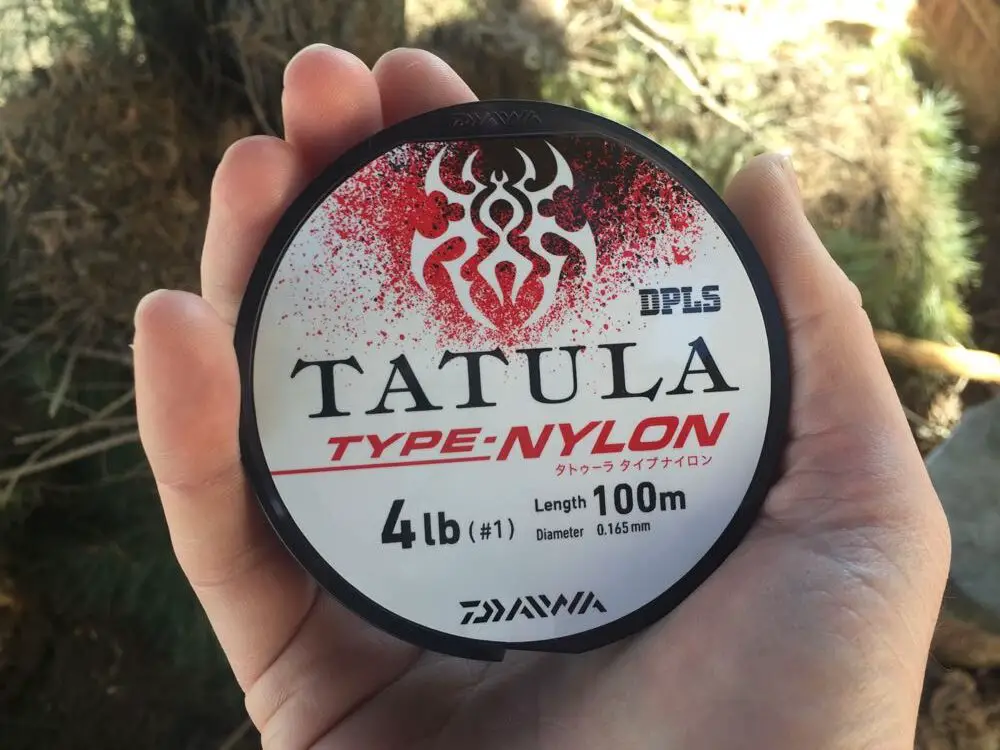
Monofilament vs Fluorocarbon vs braid / superline mainlines
While this article predominantly discusses monofilaments. I need to touch upon the other line types used for fishing. These are fluorocarbons and braids.
For trout fishing, my favorite line is braided Superlines, such as fireline or sufix fuse. I have gone into a lot more detail why I favor superlines in an earlier article. I have summarized below why I consider fireline to be the best mainline for trout fishing.
- + Superline do not stretch, allowing every touch, bump, and vibration to be felt.
- + Extremely thin diameter allowing for longer casts.
- + Superline has next to no memory, no need to worry about line twists.
- + Superline, unlike braid plays nicely with ultralight spinning reels even at low breaking strains
- – Thin superline can easily cut the skin.
- – Requires specialized knots.
- – It is very visible in the water, and requires the use of a leader.
- – Requires tools to cut, I can not bite through it.
The case for and against Fluorocarbon
To keep up to date with current and past trends in trout fishing I spend a lot of time reading blogs and articles.
There are quite a few websites, some with questionable authenticity that sing praises for trout fishing with Fluorocarbon mainlines.
I personally feel fluorocarbon has some serious drawbacks and few advantages when it comes to ultralight spin fishing.
Let’s just start at the biggest negatives.
Memory, and the resulting tangles, wind knots, and eventual bird nests.
Fluorocarbon simply does not play nicely with ultralight spinning gear. It requires constant attention to prevent it from exploding into a nest of tangles. It is simply too stiff for lightweight spin fishing.
Fluorocarbon also has much weaker knot strength, we are already fishing very light lines. This is not good news when the mainline is only 4lb.
I remember when many advertisements use to claim the ‘low stretch’ nature of Fluorocarbon. This is simply not true. Fluro, stretches as much if not more than traditional nylons.
To make matters even worse. When Fluro is overstretched, it does not rebound to its original dimensions. It stays stretched out… Do this too many times and it results in premature line breakage.
No rant against Fluorocarbon mainlines will be complete without referring to its number one claim to frame. That Fluorocarbon is nearly invisible in the water. To the human eye, that is true. Fluorocarbon is much tougher for us to see. But, in my experience trout simply do not care.
I have spent years fly fishing to trophy size brown trout in some of the clearest trout rivers around. These trout are veterans. They have seen all types of lines and presentations. When fishing for these trout, I do not think twice before tying on a dry fly and a few feet of nylon tippet. If my presentation is good, and there is no drag chances are the hungry trout will rise to the surface and gobble up my fly.
If a trout accepts a minuscule dry fly tied to a nylon tippet, there is no chance it will turn down a ‘gigantic’ spinner attached to a similar line. Now, I do use fluorocarbon when fly fishing, but only for nymphing and other presentations when I want the line to sink quickly.
Before I finish, I must quickly cover the advantages. It does have very good abrasion resistance.
This is always nice, but a high abrasion-resistant line is not a requirement for trout fishing. It also sinks faster than monofilament.
This characteristic makes it very useful for nymph fishing but it does not make much of a difference when spinning with lures.
Keep in mind, this is only discussing the use of fluorocarbon as a mainline, on ultralight spinning tackle.
It is actually quite good as a dedicated leader material, and from what I understand it behaves quite differently when fished on baitcaster in heavier breaking strains.
Which breaking strain to use for trout fishing
When choosing a fishing line for your spinning reel, it is important to match the line with the reel, rod and the size of fish you plan on targeting. Using the wrong breaking strain of line can result in lost fish, reduced casting distance or even a broken rod. All things we want to prefer.
Nearly all rods and reels have a line class line or weight printed on them. In the case of trout reels the line capacity will be printed on it, for example 110yd/6lb, sometimes the dimensions are printed alongside 140m/0.20mm. Line breaking strain is usually in Imperial (sometimes metric) while the line diameter is most often in metric.
Rods normally give a range. Most trout rods are rated for between 2-8lb or 1-3kg. Sometimes, rod manufacturers do not give a line weight, but only the lure weight the rod is designed to cast. So you will see something like 1/16oz-1/2oz instead.
What line weight for stream trout
I suggest using 4lb line for small stream trout, look for a line with a diameter no thicker than 0.008″.
This is an ideal line for targeting the tiny stream trout, such as brook char which live in the foothills of the Appalachian mountains.
Just take care when tightening knots and fighting fish. . There is not much margin of error. If your line suffers from any abrasion, I suggest cutting off the damaged portion of line.
My preferred 4lb lines are Maxima Ultragreen or Sunline Super Natural.
What line weight for Steelhead fishing?
The best breaking strain to use for steelhead fishing is between 8-12lb. Most of the time I use a mainline with a diameter of around 0.01″ or 0.25mm. This is approximately 8lb.
Steelhead trout are larger, and fart stronger than most. So anglers use slightly stronger lines. On North American rivers over 90% of steelhead fishermen use line between 8-12lb in breaking strain.
If the river is fast, and the current strong anglers tend to use slightly heavier line to better control the fish. When fishing from boat’s 8lb line can be used. Many steelhead anglers also use a leader of between 10-15lb, but a thinner diameter leader spooks less fish in clear conditions.
My preferred line to use for Steelhead fishing is Sufix Elite
What line weight for Searun trout
I generally use a 0.009″ line (0.23mm) when targeting searun brown trout. This has a breaking strain of around 6-8lb
Searun trout are bigger and fight harder than river trout. So the line used by dedicated fishermen has a slightly higher breaking strain. The ideal breaking strain to use also depends largely on where you plan on fishing.
Some rivers simply have larger, more powerful sea run trout. Such as Lake Thingvallavatn in Iceland or the Rio Grande in Argentina where the trout can exceed 30lb in weight. In such trophy trout waters 12lb line is often recommended.
My preferred lines to use for sea run trout and steelhead is Sufix Elite or Stren Original
Can trout see bright color fishing lines?
Fishing line comes in many colors, but for trout fishing, conventional wisdom favors clear, less visible line. Many lines have a green, blue, or even whitish tinge… I am not aware of the slight variations in color really matter.
People often believe trout do not strike when they can see the line, but that is far from the truth. They normally see micro drag or something else unnatural which convinces them not to strike. So, can trout be caught on high-vis orange or yellow mainlines? Probably, but I have never met anyone brave enough to try. So why take the risk?
These bright colors lines exist to be easier to see. Not only for anyone with poor eyesight but for birds. It is not a big concern for spin fishermen, but bird strike can be a real consideration for some sea fishermen. If you trout fish with high visibility lines I will love to hear your feedback in the comments below.
Best fishing line for trolling?
Most of the time, a thin line works best when trolling because it sinks through the water faster. For this reason, braided fishing lines such as fireline work extremely well for trolling.
If you wish to stick with monofilament, I suggest a line such as Stren Megathin or Sunline Super Natural due to their low diameter. Megathin, is likely the better of the two thanks to less memory.
When to replace fishing line?
If you are unsure whether your line needs to be replaced or not, I have just written a guide here explaining when to replace your fishing line.
